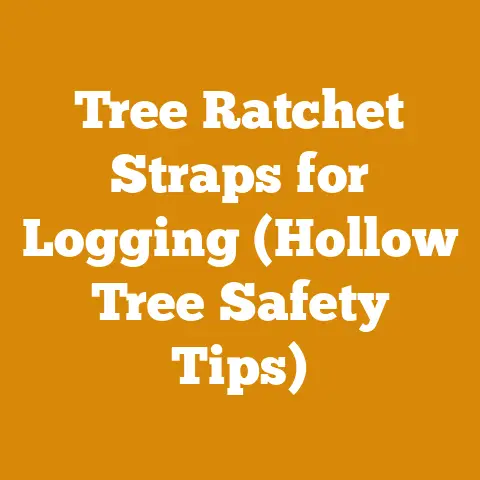Stump-Killer Herbicides Guide (5 Pro Tips for Woodworkers)
Let’s talk about future-proofing your land. I’ve spent years felling trees, processing timber, and preparing firewood. And one thing I’ve learned is that dealing with the aftermath – specifically, tree stumps – can be a real pain. They’re unsightly, hazardous, and can sprout new growth, undoing all your hard work. That’s where stump-killer herbicides come in. This guide isn’t just about spraying chemicals; it’s about understanding the science, choosing the right tools, and employing effective techniques to eliminate stumps efficiently and safely. I’ll share my tried-and-true methods, learned from years in the field, to help you reclaim your land.
Stump-Killer Herbicides Guide: 5 Pro Tips for Woodworkers
Stump removal can be a back-breaking task. Digging, grinding, or even burning are options, but they’re often time-consuming and labor-intensive. Stump-killer herbicides offer a more manageable solution, especially for larger stumps or when you have multiple stumps to tackle. This guide will walk you through everything you need to know, from selecting the right herbicide to applying it effectively, ensuring you achieve the desired results without harming the surrounding environment.
1. Understanding the Enemy: Stump Biology and Herbicide Action
Before you reach for the herbicide, it’s crucial to understand how stumps work and how these chemicals actually kill them. We’re not just talking about dead wood; we’re dealing with a living organism trying to survive.
What is a Tree Stump?
A tree stump is what remains of a tree after it has been cut down. It includes the visible portion above ground and the root system below. The stump retains a connection to the root system, allowing it to potentially regrow or send up suckers (new shoots) from the roots. This is where the problem lies for woodworkers and landowners; unwanted regrowth can quickly undo the efforts of felling the tree in the first place.
Green Wood vs. Seasoned Wood: Impact on Herbicide Absorption
This is a crucial distinction. Green wood refers to freshly cut wood that still contains a high moisture content. Seasoned wood, on the other hand, has been dried, reducing its moisture content. Green wood absorbs herbicides much more readily than seasoned wood. Why? Because the vascular system of the tree, which is responsible for transporting water and nutrients, is still active in green wood. This system acts as a pathway for the herbicide to reach the roots. In seasoned wood, this system is largely inactive, making herbicide absorption significantly less effective.
In my experience, I’ve seen herbicides fail completely on stumps that were allowed to dry out for even a few weeks. The key is to apply the herbicide as soon as possible after felling the tree.
How Herbicides Work: Systemic vs. Contact
There are two main types of herbicides:
- Systemic Herbicides: These are absorbed by the plant and translocated throughout the entire system, including the roots. This is the preferred type for stump treatment because it ensures that the entire root system is killed, preventing regrowth. Examples include glyphosate and triclopyr.
- Contact Herbicides: These only kill the parts of the plant they come into direct contact with. They are not effective for stump treatment because they won’t reach the roots.
Glyphosate is a broad-spectrum systemic herbicide, meaning it will kill most plants it comes into contact with. Triclopyr, on the other hand, is a selective systemic herbicide that is more effective on woody plants and less harmful to grasses.
Case Study: Failed Herbicide Application
I once worked on a project clearing a large area of invasive buckthorn. We felled the trees and then waited several weeks before applying glyphosate to the stumps. The result? A significant portion of the stumps sprouted new growth the following spring. We had to go back and re-treat them, wasting time and resources. This experience taught me the importance of applying herbicides promptly to freshly cut stumps.
2. Choosing the Right Herbicide: A Woodworker’s Arsenal
Selecting the appropriate herbicide is crucial for success. It depends on the type of tree, the desired outcome, and environmental considerations.
Glyphosate: The Generalist
Glyphosate is a widely available and relatively inexpensive herbicide. It’s effective on a broad range of tree species. However, it’s also non-selective, meaning it will kill any plant it comes into contact with. This is a concern if you have desirable vegetation nearby.
- Pros: Broad-spectrum, readily available, relatively inexpensive.
- Cons: Non-selective, can harm desirable plants, may require multiple applications for certain species.
Dosage: Follow the manufacturer’s instructions carefully. A common concentration for stump treatment is a 50% solution (equal parts herbicide and water).
Triclopyr: The Specialist
Triclopyr is a selective herbicide that is more effective on woody plants and less harmful to grasses. This makes it a better choice if you are concerned about damaging nearby lawns or other desirable vegetation.
- Pros: Selective, effective on woody plants, less harmful to grasses.
- Cons: More expensive than glyphosate, may not be effective on all tree species.
Dosage: Again, follow the manufacturer’s instructions. A common concentration for stump treatment is a 25% solution (one part herbicide to three parts water).
Herbicide Selection Chart
| Tree Species | Recommended Herbicide(s) | Notes |
|---|---|---|
| Oak | Triclopyr | Oak can be resistant to glyphosate. |
| Maple | Glyphosate or Triclopyr | Both are generally effective. |
| Pine | Glyphosate | Pine is usually susceptible to glyphosate. |
| Birch | Glyphosate or Triclopyr | Both can be used, but triclopyr may be more effective on larger stumps. |
| Invasive Species (e.g., Buckthorn, Ailanthus) | Triclopyr | Triclopyr is often the better choice for invasive species, as it is more effective at preventing regrowth. |
| General Use | Glyphosate | If unsure, glyphosate is a good starting point, but be mindful of non-target plants. |
Important Note: Always read and follow the manufacturer’s instructions on the herbicide label. The label is the law!
Considerations for Organic Woodworkers
If you’re committed to organic practices, chemical herbicides are obviously out of the question. In this case, you’ll need to rely on mechanical removal (digging or grinding) or other non-chemical methods. While these methods are more labor-intensive, they align with organic principles.
3. The Cut-Stump Treatment Method: The Step-by-Step Guide
This is the most common and effective method for applying stump-killer herbicides. It involves cutting the stump as close to the ground as possible and then applying the herbicide directly to the freshly cut surface.
Step 1: Gear Up: Safety First
Safety is paramount when working with herbicides. Before you start, gather the following personal protective equipment (PPE):
- Gloves: Chemical-resistant gloves are essential to protect your skin from direct contact with the herbicide.
- Eye Protection: Safety glasses or goggles will prevent herbicide from splashing into your eyes.
- Long Sleeves and Pants: Cover your skin to minimize exposure.
- Respirator (Optional): If you are working in a confined space or are sensitive to chemicals, a respirator is recommended.
Step 2: The Felling Cut: Setting the Stage
When felling the tree, plan your cut carefully. Aim to cut the tree as close to the ground as safely possible. This will make stump removal easier and less noticeable.
Chainsaw Selection: I typically use a 20-inch chainsaw (like a Stihl MS 271 or Husqvarna 455 Rancher) for felling trees up to 24 inches in diameter. For larger trees, a more powerful saw with a longer bar is necessary. Remember to keep your chain sharp for efficient cutting.
Felling Techniques: Use proper felling techniques, including making a notch cut (open face cut) and a back cut, to control the direction of the fall. This is crucial for safety and prevents damage to surrounding property.
Step 3: The Fresh Cut: Maximizing Absorption
Immediately after felling the tree, make a fresh cut on the stump, ensuring the surface is clean and free of debris. This is critical for maximizing herbicide absorption. If the stump has been cut for a while, use a chainsaw to remove a thin layer of wood, exposing fresh tissue.
Why Fresh Cuts Matter: As I mentioned earlier, the vascular system is still active in freshly cut wood. This allows the herbicide to be drawn into the roots more effectively.
Step 4: Herbicide Application: The Right Technique
There are two main techniques for applying herbicide to the cut stump:
- Painting: Use a paintbrush or foam applicator to apply the herbicide solution to the entire cut surface of the stump, focusing on the outer edge (cambium layer) where the vascular tissue is most concentrated. This method is precise and minimizes overspray.
- Spraying: Use a garden sprayer to apply the herbicide solution to the cut surface. This method is faster but can result in overspray, potentially harming nearby plants.
My preferred method is painting. I find it gives me more control and reduces the risk of damaging surrounding vegetation.
Specific Instructions:
- Apply the herbicide immediately after making the fresh cut. Don’t wait!
- Saturate the entire cut surface, especially the cambium layer (the ring just under the bark). This is where the active transport of nutrients occurs.
- Avoid applying herbicide on rainy days, as the rain will wash it away.
- Do not apply herbicide if the ground is frozen, as the herbicide will not be absorbed.
Step 5: Monitoring and Reapplication: The Long Game
After applying the herbicide, monitor the stump for signs of regrowth. This may take several weeks or even months, depending on the tree species and the effectiveness of the herbicide. If you see new shoots emerging, reapply the herbicide immediately.
Signs of Success:
- The stump will gradually die and decay.
- No new shoots will emerge.
- The bark will begin to loosen and fall off.
Case Study: Stubborn Maple Stump
I had a particularly stubborn maple stump that I treated with glyphosate. Despite multiple applications, it continued to send up new shoots. I eventually switched to triclopyr, and that finally did the trick. This highlights the importance of being persistent and trying different herbicides if necessary.
4. Alternative Application Methods: Beyond the Basics
While the cut-stump treatment method is the most effective, there are a few alternative methods that may be useful in certain situations.
The Frill-Cut Method
This method is used for larger trees that are difficult to fell or when you want to avoid cutting the tree down completely. It involves making overlapping downward cuts (frills) around the circumference of the tree trunk, exposing the cambium layer. The herbicide is then applied directly into the frills.
- Pros: Can be used on standing trees, avoids the need for felling.
- Cons: More labor-intensive than the cut-stump method, may not be as effective.
The Basal Bark Treatment Method
This method involves applying herbicide to the lower portion of the tree trunk, saturating the bark. The herbicide is absorbed through the bark and translocated to the roots. This method is typically used for smaller trees with thin bark.
- Pros: Can be used on standing trees, relatively easy to apply.
- Cons: Only effective on smaller trees with thin bark, requires specialized herbicides.
Important Note: These alternative methods are generally less effective than the cut-stump treatment method and should only be used when necessary.
5. Environmental Considerations: Protecting Our Planet
It’s crucial to use herbicides responsibly and minimize their impact on the environment.
Minimizing Herbicide Use
- Use the correct dosage: Don’t use more herbicide than necessary. Follow the manufacturer’s instructions carefully.
- Apply herbicide directly to the target plant: Avoid overspray and drift.
- Consider alternative methods: Explore non-chemical methods of stump removal, such as digging or grinding.
Protecting Water Sources
- Do not apply herbicide near water sources: Herbicides can contaminate water and harm aquatic life.
- Choose herbicides that are less toxic to aquatic organisms: Glyphosate is generally considered less toxic than some other herbicides.
Protecting Wildlife
- Avoid applying herbicide in areas where wildlife is present: Herbicides can harm wildlife if ingested or inhaled.
- Choose herbicides that are less toxic to wildlife: Triclopyr is generally considered less toxic to mammals than some other herbicides.
Disposal of Herbicides
- Dispose of unused herbicide properly: Do not pour it down the drain or into the ground. Contact your local waste management agency for disposal instructions.
- Rinse empty herbicide containers thoroughly: Follow the manufacturer’s instructions for rinsing and disposal.
My Personal Pledge: I always strive to use the minimum amount of herbicide necessary to achieve the desired results. I also take extra precautions to protect water sources and wildlife. We have a responsibility to use these tools responsibly and protect our environment for future generations.
Strategic Insights: Beyond the tactical steps, consider the long-term implications. Are you clearing land for development? Or managing a woodlot for sustainable forestry? Your goals will influence your choice of herbicides and application methods. For example, if you are managing a woodlot, you may want to use a selective herbicide to avoid damaging desirable trees.
Tools and Machinery:
- Chainsaws: Stihl MS 271, Husqvarna 455 Rancher, Stihl MS 462 R C-M (for larger trees)
- Axes: Fiskars X27 Splitting Axe, Gransfors Bruks Small Forest Axe
- Log Splitters: Hydraulic log splitters (20-30 ton capacity) significantly increase efficiency for firewood preparation.
- Sprayers: Backpack sprayers, handheld sprayers
- Paintbrushes/Foam Applicators: For precise herbicide application.
Cost Considerations: The cost of herbicide varies depending on the type, concentration, and quantity purchased. Glyphosate is generally less expensive than triclopyr. The cost of application also depends on the size and number of stumps. Labor costs can be significant if you are hiring someone to apply the herbicide.
Skill Level Required: Applying stump-killer herbicides is a relatively simple task, but it requires attention to detail and adherence to safety precautions. Beginners should start with small projects and gradually increase their experience.
Practical Next Steps:
- Identify the tree species you need to remove.
- Research the appropriate herbicide for that species.
- Gather the necessary PPE.
- Fell the tree using proper felling techniques.
- Make a fresh cut on the stump.
- Apply the herbicide according to the manufacturer’s instructions.
- Monitor the stump for signs of regrowth.
- Reapply herbicide if necessary.
By following these steps and using the pro tips I’ve shared, you can effectively eliminate tree stumps and reclaim your land. Remember to always prioritize safety and use herbicides responsibly. Good luck!






